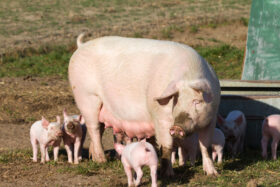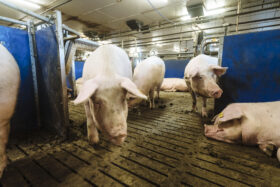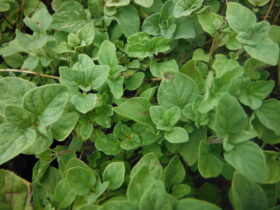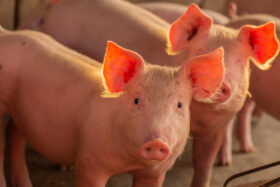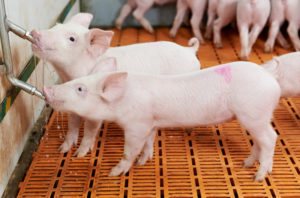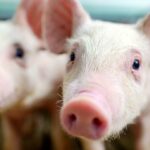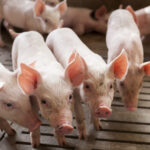Piglets experience significant stress when they are weaned from the sow and change diet, making them susceptible to gastrointestinal disorders. Primarily during the first two weeks after weaning, they are likely to suffer from post-weaning diarrhea (PWD). PWD is a significant problem for pig producers worldwide: it leads to severe dehydration, stunted growth and mortality rates of up to 20-30%. Treatment and additional labor costs further squeeze farm profitability and necessitate unwanted antibiotic interventions.
Zinc oxide: an effective but highly problematic tool
Since the early 1990s zinc oxide (ZnO) has been used to control post-weaning diarrhea and promote growth in piglets, mainly at pharmacological dosages of 2500 to 3000ppm. Its mode of action is still not entirely understood; effects on immune or metabolic processes, altered microbiota, or post-absorptive metabolism are likely to play a role. What is clear is that the use of ZnO in European pig production has strongly increased since the EU banned the use of antibiotic growth promoters such as colistin in 2006 to curb the development of antimicrobial resistance.
Pigs depend on a continuous supply of zinc. Among other roles, this trace element constitutes a functional component of around 300 biochemical enzymes, making it pivotal to most metabolic processes, and by extension to optimal health, production and reproduction. Modern pig diets thus include zinc supplementation to meet the animals’ requirements. The European Food Safety Authority (EFSA) currently suggests that a total level of 150ppm of zinc in feed matches the animals’ physiological need for zinc. The EFSAs concerns are solely connected to the environmental concerns arising from pharmacological high dosages of ZnO.
These concerns are grave indeed: zinc is a heavy metal after all. Too much zinc is toxic for the animal, hence its physiology ensures that excessive zinc intake is excreted. The bioavailability and absorption of zinc from zinc oxide is particularly low. Therefore most of the zinc given to piglets in this way accumulates in their manure – which is widely used as an organic fertilizer for agricultural soils.
The continual application of manure gradually increases topsoil zinc concentrations; leaching and run-off then lead to contamination of groundwater, surface waters, and sediment. As zinc is non-volatile and non-degradable, it is only a matter of time before concentrations lead to ecotoxic effects, including food crops, aquatic life, and drinking water. Classic mitigation measures such as diluting the manure or keeping certain minimum distances between application areas and surface waters can only slow down the environmental accumulation of zinc, not prevent it.
EU ban: ZnO to be phased out by 2022
In 2017, the European Medicines Agency (EMA) – the EU agency responsible for the scientific evaluation, supervision and safety monitoring of medicines, including veterinary medicinal products – conducted an overall risk-benefit analysis for ZnO. It concluded that the benefits of preventing diarrhea in pigs did not outweigh the significant environmental risks caused by zinc pollution. By June 2022 all EU member states will thus have to withdraw marketing authorizations for veterinary medicinal products containing zinc oxide that are administered orally to food-producing species.
In its decision, the EMA’s Committee for Medicinal Products for Veterinary Use also points out the risk that, due to co-resistance, the use of zinc oxide might promote the development of antimicrobial resistance. High doses of zinc supplementation have been shown to increase the proportion of multidrug-resistant E. coli and Salmonella, two of the most important pathogens in pig production.
What is more, studies show that excessive zinc can accumulate in the liver, the pancreas, and blood serum, and that it permanently reduces the lactobacilli population of the gut flora. With what consequences for performance in the fattening phase? Hence, there are plenty of reasons why getting rid of zinc oxide is a good thing and will ultimately result in even better, more sustainable pig production – but, of course, only if effective replacement strategies to control PWD and boost piglet performance are in place.
Towards zero ZnO: smart feed additives optimize gut health
The search for ZnO alternatives takes us right back to the start, to the piglets’ challenged gastrointestinal tract. During their first three months of life, pigs’ gastrointestinal system undergoes a complex maturation process of its epithelial, immune, and enteric nervous systems. Only once all of these systems are fully developed is the gut capable of delivering its normal functions (digestion, nutrient absorption, immunity, etc.), while also providing an effective barrier against the pathogens, antigens, and toxins in the lumen.
Unlike in nature, where weaning occurs around the time when GIT functions have matured, weaning in commercial pig production takes place during this vulnerable developmental period. Post-weaning diarrhea is ultimately a consequence of intestinal dysbiosis, a state of imbalance in the intestinal microbiome which in turn is induced by the dietary, behavioral, and environmental stressors of the weaning phase (such as separation from the sow, vaccinations, transport, introduction of solid feed).
PWD control thus starts with managing these stressors, which includes ensuring sufficient colostrum intake, gradual feed changes, and meticulous nursery hygiene. Critically, the weaning diet needs to optimally support gut health. Intelligent feed additive solutions are able to
- reduce the pathogenic load in the piglet’s GIT,
- strengthen the piglet’s maturing gut barrier functionality, and
- selectively induce the development of beneficial microorganisms within the microbiome.
A synergistic combination of phytomolecules, medium-chain fatty acids, glycerides of butyric acid, and prebiotics achieves these objectives in a reliable and cost-effective manner. Thanks to their antimicrobial, anti-inflammatory, and digestive properties these selected ingredients effectively support piglets during this critical phase of their postnatal gut development, while also boosting their feed intake.
In the past decade, the European pig sector has successfully adapted to the 2006 ban on antibiotic growth promoters through significant improvements in management and feed practices. Cutting out zinc oxide is an ambitious challenge – but with the support of targeted, functional feed additives, producers will be able to set their piglets up for a strong, sustainable, zero ZnO health and growth performance.
*You can find this article in polish and italian.
References
Amezcua, Rocio, Robert M. Friendship, Catherine E. Dewey, Carlton Gyles, and John M. Fairbrother. “Presentation of postweaning Escherichia coli diarrhea in southern Ontario, prevalence of hemolytic E. coli serogroups involved, and their antimicrobial resistance patterns.” Canadian Journal of Veterinary Research 66, no. 2 (April 2002): 73-8. https://www.ncbi.nlm.nih.gov/pmc/articles/PMC226986/.
Bednorz, Carmen, Kathrin Oelgeschläger, Bianca Kinnemann, Susanne Hartmann, Konrad Neumann, Robert Pieper, Astrid Bethe, et al. “The Broader Context of Antibiotic Resistance: Zinc Feed Supplementation of Piglets Increases the Proportion of Multi-Resistant Escherichia Coli in Vivo.” International Journal of Medical Microbiology 303, no. 6-7 (2013): 396–403. https://doi.org/10.1016/j.ijmm.2013.06.004.
Brugger, Daniel, and Wilhelm M. Windisch. “Strategies and Challenges to Increase the Precision in Feeding Zinc to Monogastric Livestock.” Animal Nutrition 3, no. 2 (March 24, 2017): 103–8. https://doi.org/10.1016/j.aninu.2017.03.002.
Burrough, Eric R., Carson De Mille, and Nicholas K. Gabler. “Zinc Overload in Weaned Pigs: Tissue Accumulation, Pathology, and Growth Impacts.” Journal of Veterinary Diagnostic Investigation 31, no. 4 (June 6, 2019): 537–45. https://doi.org/10.1177/1040638719852144.
De Mille, Carson, Emma T. Helm, Eric R. Burrough, and Nicholas K. Gabler. “Zinc oxide does not alter ex vivo intestinal integrity or active nutrient transport in nursery pigs.” Paper presented at the Zero Zinc Summit, Copenhagen, Denmark, June 17-18, 2019. https://svineproduktion.dk/Services/-/media/3E0A1D2A4CAC409FAA6212B91DFEA537.ashx.
Moeser, Adam J., Calvin S. Pohl, and Mrigendra Rajput. “Weaning Stress and Gastrointestinal Barrier Development: Implications for Lifelong Gut Health in Pigs.” Animal Nutrition 3, no. 4 (December 2017): 313–21. https://doi.org/10.1016/j.aninu.2017.06.003.
Rhouma, Mohamed, Francis Beaudry, William Thériault, and Ann Letellier. “Colistin in Pig Production: Chemistry, Mechanism of Antibacterial Action, Microbial Resistance Emergence, and One Health Perspectives.” Frontiers in Microbiology 7 (November 11, 2016): Article 1789. https://doi.org/10.3389/fmicb.2016.01789.
Starke, Ingo C., Robert Pieper, Konrad Neumann, Jürgen Zentek, and Wilfried Vahjen. “The Impact of High Dietary Zinc Oxide on the Development of the Intestinal Microbiota in Weaned Piglets.” FEMS Microbiology Ecology 87, no. 2 (February 1, 2014): 416–27. https://doi.org/10.1111/1574-6941.12233.
